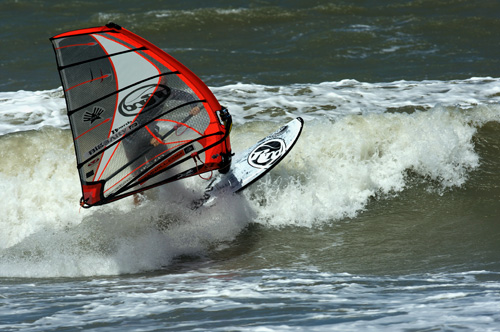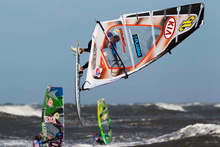
Jem Hall continues to give you a break from his fully frontside series as he gets you working on your backside waveriding. Photos by Dave White
As we move into summer and find ourselves out in smaller waves and perhaps onshore conditions we should now be looking to show our backsides with pride.
Backside is not often practiced. People who sail in waves as opposed to wavesailors often ignore these enticing lumps on the way in as they boy-race their way through the break, and advanced sailors just want to go frontside, dude! But backside done well is great fun. You can make it rad and it can lead you into your frontside turns in cross-shore winds, as the wave forms up while you’re stalling for this to happen. It will also enable you to work sections of the wave before you go frontside in cross-on – but more on that later.
The jumps you’re now doing will help with backside aerials and jumps – backside airs on the way in mean you get good at jumping both ways. Getting proficient and eventually vertical backside leads to some great turns and will improve your frontside as your timing, aggression and technique will be constantly improving. You can’t but be impressed by some of the backside antics our illustrious pros get up to in sloppy conditions like Pozo or Sylt – and of course in quality waves like the left at Lanes, which you see in a lot of vids.
It’s all in the name. When you’re waveriding backside you have your back to the wave and you are indeed using your arse and hips to help you change direction. As you are backside you’ll be going upwind and there will thus be less power in the sail, and as such it’s a good initiation into easy riding. You are more able to suck it and see as you develop your gentle turns into more vertical and aggressive riding.
The rules…
The basic ground rules follow the guidelines for all your fundamental windsurfing skills. Basically it’s all about the head and hands!
The head Where your head goes your body will follow. Exaggerating this movement of the head is often the easiest way to improve your riding and all-round sailing.
The hands While waveriding your back hand should really be working up and down the boom. The front hand should also not be too far forward on the boom.
At first I suggest not going for top or bottom turns, but just practice staying on the wave while unhooked, which will help you when you get into your top turns.
Aim to make little turns on your heels and toes, heels towards the bottom of the wave and toes towards the middle or top of the wave. You can also do this in rolling swell to get a feel for it.
Turn your head to look upwind for your heelside turn, and then look downwind to come back down the wave and get your speed back up.
These will be your first backside bottom and top turns…




